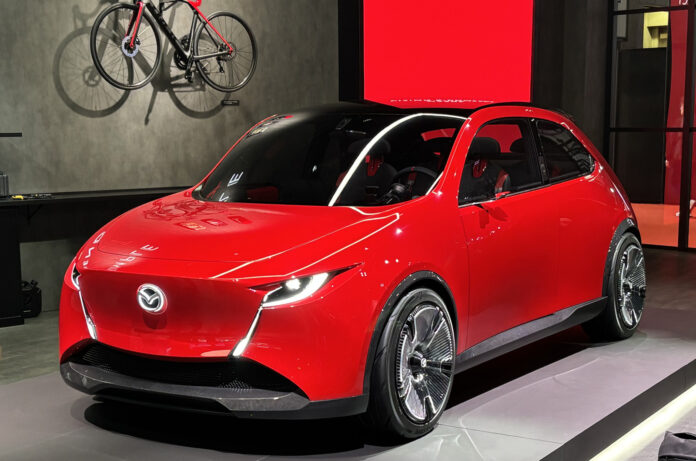To which end, the Vision X-Compact is hypothetically capable of reading a driver’s emotions and responding to them appropriately. “It can sense what you are feeling right now: if you think it’s boring, if you think it’s too hard, if you want to seek something to do – the car can sense that, and can propose something,” Umechida said.”
He wants Mazda customers to see their car as a “very good, intimate friend” – a notion which should appeal particularly to young people who do a lot of virtual activities at home.
“If you can have that partner, if you can drive further and go outside rather than stay at home and do a virtual thing, probably that can be a good proposal for Mazda.”
That’s chiefly why Mazda is showcasing the futuristic technology in a small car that clearly majors on affordability in its conception, with a spartan dashboard, a phone mount in place of an infotainment screen, and proportions that line it up as a rival to the likes of the Suzuki Swift and Toyota Aygo X.
I want younger-generation people to feel and enjoy it,” said Umechida, adding that the firm is monitoring reaction to the concept – and will make a decision based on feedback.
“I am showcasing that vision car, and if you support it, we want to produce it once again.”
While the exterior styling is heavily based on Mazda’s Kodo design language and clearly related to its current production cars, the interior is a radical departure from its current cabins.
It has a classic-style three-spoke steering wheel, a simple digital driver’s display and a physical drive selector that looks like a manual gearstick. The dashboard is otherwise completely unadorned, going without a touchscreen or even any upholstery.
The company hasn’t even said whether the Vision X-Compact is hypothetically powered by an electric or combustion-based powertrain. The previous 2 used a 1.5-litre naturally aspirated petrol engine, while the 2 Hybrid uses the same full-hybrid system as the Yaris it’s based on.
